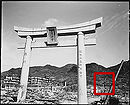
Sanno Shrine
Encyclopedia

Torii
A is a traditional Japanese gate most commonly found at the entrance of or within a Shinto shrine, where it symbolically marks the transition from the profane to the sacred...
at the shrine entrance.
Torii

The epicenter of the bomb's destructive force was located appromimately 800 meters from the shrine (in the right background of the image the deformed torii on this page).
One support column was knocked down; but the other somehow remained standing, even though it was rotated about 30 degrees on its pedestal base. The central part of the shrine is located just behind where the photographer would have stood in order to capture the recent photograph which shows the current state of the still-standing column.
Trees


The dead parts of the living trees have been enveloped by new growth.

